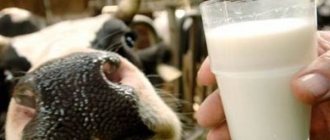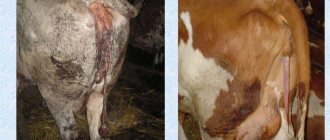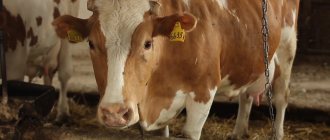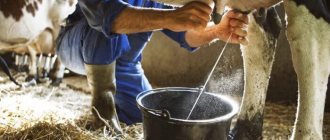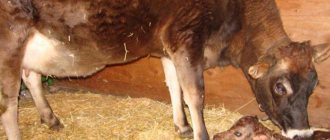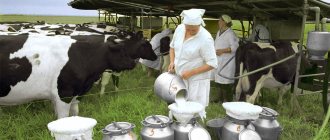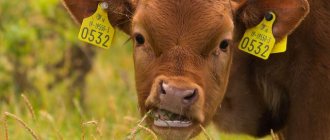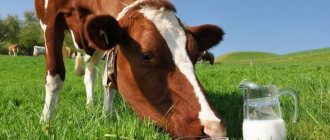Cow insemination
In order for the nurse to regularly provide milk, she needs to give birth to a calf every year. Cows can be inseminated either with a bull or artificially. Both methods have both their advantages and disadvantages.
The advantage of bull insemination is the high percentage of coverage. After all, animals themselves are able to determine the ideal time for effective mating. Also, bulls are always on hand; most cow owners keep them for meat. The disadvantage of this method is the likelihood of the nurse becoming infected with sexually transmitted diseases. Also, breeders do not recommend breeding cows with bulls of unknown origin, since the offspring may not be dairy.
Artificial insemination, carried out by a qualified specialist, virtually eliminates the possibility of a cow becoming infected with sexually transmitted diseases. The resulting offspring usually have much greater potential than the mother. It is possible to choose the material of a bull that produces small calves, which is important for first-time cows. The appearance of mucous discharge in a cow after insemination is normal.
Waiting for offspring
How long does a cow's pregnancy last? Childbirth is a rather complex process; it will occur only when the animal’s body is completely ready for it. Therefore, pregnancy periods may differ, both positive and negative. Farmers are usually concerned with how to determine if a cow is pregnant and how long it takes before giving birth. On average, pregnancy in cows lasts 285 days.
This does not mean that calving will begin after this amount of time. Some cows always go to term, while others, on the contrary, do not carry to term. It all depends on individual characteristics, quality of care, and balanced diet. But if calving is very delayed, then you must definitely invite a doctor. This is due to the fact that the baby grows in the womb and becomes larger every day. When the fetus is too large, the cow may have difficulty calving and will need assistance.
How long does a pregnant cow walk?
A cow's pregnancy lasts 9.5 months (about 285 days). It must be taken into account that in some cases she may not carry or carry the calf.
Thus, due to unfavorable living conditions, childbirth may occur a month earlier than expected, and due to poor nutrition - 10 days later. In addition, scientists have proven that heifers are born 1-2 days earlier than bulls.
Be sure to read:
Milking machine for cows at home, operating principle of AID-2, instructions
Is it possible to determine pregnancy without a veterinarian?
Not all villages have a doctor, so people often have to determine pregnancy on their own. There are several methods, but each of them is most optimal for a specific period. The owner must know how long the cow's pregnancy lasts and when she was inseminated. It is optimal to use several methods at once, so the result will be more accurate.
The most popular ways to determine pregnancy:
- using cow's milk;
- pregnancy test;
- palpation;
- rectal examination;
- donating blood for analysis.
One of the most accurate methods is ultrasound examination. Using the device you can see the presence of fruits and their quantity. Unfortunately, this diagnostic method is not available to most villagers.
Methods depending on timing
Up to 30 days
Behavior change
When pregnancy occurs, the cow's behavior becomes calmer. The animal has a good appetite and is not in a state of hunting. The first sign is also vaginal discharge: mucus or dried crusts on the outside of the genitals. According to the observations of experienced specialists, the fur of a pregnant cow is smooth and shiny, while that of a barn cow, on the contrary, puffs up like a hedgehog.
Pregnancy test
In order to determine the pregnancy of a cow, many enterprises use special rapid tests. The method is based on a reaction to detect the amount of progesterone, which is responsible for ovulation, in milk samples. Test strips can show a reliable result as early as the 23rd day of pregnancy, since an increase in progesterone levels occurs on days 18–22. Two main methods should be distinguished: A drop of milk is dropped using a pipette into a glass containing water from a height of 5–6 cm. If the cow is pregnant, the milk dissolves without leaving a trace. With the help of a drop of milk, a “cloud” is formed, which instantly spreads in the water (in non-pregnant cows).
Pour 5 ml of fresh milk and pure alcohol into the test tube, then shake. The milk of a pregnant animal coagulates immediately or within 3–5 minutes. For milk from a non-pregnant cow, the process will take 20–40 minutes. The accuracy of the method is 70–76%. These tests can also be carried out at home and do not always serve as a completely reliable method for determination. They are usually preceded by more serious examinations. After 30 days
Blood chemistry
Upon reaching 1 month of pregnancy, we can talk about changes in the hormonal composition of the blood. With the help of biochemical research in laboratory conditions, minor changes can be easily determined, and the result is as reliable as possible. But if 90 days have not passed since the last pregnancy, the test results will be based on the previous pregnancy.
The most effective test for determining the pregnancy of a cow. A special ultrasound scanner is inserted by an experienced veterinarian into the cow’s vagina, reflecting data on the presence of pregnancy and possible abnormalities. It is better not to use this diagnostic method before 30 days, since the possibility of a miscarriage increases significantly.
Visual signs of pregnancy
How to determine if a cow is pregnant? You can focus on visual signs of pregnancy. Particular attention should be paid to discharge from the vulva. During pregnancy, they become transparent and viscous. In the last stages of pregnancy, the abdominal wall, legs, and udder swell in animals.
Some experts, focusing on visual signs of pregnancy in a cow, recommend paying attention to the coat. In coated cows, under the influence of hormones it becomes smooth and shiny. Barn cows may have wool that is raised and dull.
In animals during the period of deep pregnancy, the shape of the abdomen changes greatly: its right side becomes larger than the left. Some individuals during pregnancy do not want to give milk to the owner, and milking cows turns into torture. This is another indirect sign that the cow has become covered.
How to feel a calf in a cow's belly?
After 4 months of pregnancy, you can try the manual diagnostic method. With this method, the owner or veterinarian tries to feel the fetus with his hands through the right abdominal wall. With this method, you need to be careful not to harm the cow and calf.
The right hand is placed on the nurse’s back, and with the left hand they press on her abdominal wall 45 centimeters below the hungry hole. They make a few pushes and stop. There is no need to remove your hand; it remains in the same place. After some time, the owner may feel the calf kicking. The longer a cow's pregnancy, the more noticeable they will be.
This method is useless to use before the 4th month of pregnancy, since most likely the owner will not feel anything. Diagnosis should be carried out before feeding the animal, as it is possible to confuse the work of the stomach with fetal tremors. This method is more suitable for experienced cow owners, as beginners may not understand anything.
How to determine if a cow is pregnant
Today, there are many effective methods for determining the pregnancy of a cow, both for home use and those that require special equipment. Let's look at how to check if a cow is pregnant using folk remedies and special tests.
On your own at home
You can find out whether a cow is covered or not using various folk methods, which are based on visual inspection, diagnostics using milk or rapid tests.
Important! When determining pregnancy, experts recommend using several methods at once to ensure the reliability of the results obtained.
Diagnostics using milk
One of the most popular methods for detecting pregnancy in a cow is the analysis of its milk. There are two verification options:
- Option 1. You need to take one glass of clean ordinary water and drop a little milk into it from a height of at least 60 mm. If the milk completely dissolves as it is immersed in the liquid, we can talk about the animal being pregnant. In the absence of pregnancy, milk will form a film on the surface of the water, which will begin to blur over time.
- Option 2. To conduct the next experiment, you need to add the same amount of fresh milk to 5 ml of alcohol. If the milk curdles within 4-5 minutes, then the cow is pregnant; if it takes about 20 minutes for this to happen, then there is no pregnancy.
We recommend reading: Labrador dog. Description, features, types, character and price of the Labrador breed. The article will tell you in detail about the Labrador breed, its characteristics, character and price.
Video: how to check a cow for pregnancy As for the accuracy of such milk diagnostics, the first option is considered the least accurate, but the reliability of the second option is 75%.
Manual method
The manual method of determining the “interesting position” by palpating the abdomen of a cow is relevant only in the later stages, because you can physically palpate a calf only from four months. For diagnosis, it is necessary to place the palm on the right side of the animal 50 cm below the hungry fossa, slightly behind the arch of the rib.
Important! This method is best practiced in the morning, before the cow begins to eat food, since the baby’s kicks can easily be confused with the functioning of the digestive system.
Next, you should make rhythmic, gentle pushes directed down the abdomen, which will help determine the presence/absence of an embryo. Having carried out such manipulations, you can feel small response tremors of the fetus. It should be noted that the longer the pregnancy period, the more clearly the fetal kicks are heard.
Pregnancy test
In veterinary pharmacies you can purchase special rapid tests that allow you to independently detect the pregnancy of a cow at home. Such diagnostics, compared to traditional methods, has a number of advantages:
- can be used in the household without the involvement of experienced veterinarians or special equipment;
- gives 99.9% accurate results already in the third week after fertilization;
- takes little time (about 10–15 minutes);
- is absolutely safe for both the fetus and the animal.
Important! To check for pregnancy, tests designed specifically for cattle should be used. Tests that are designed for women will not give an accurate result.
Express tests are special test tubes, in the middle of which there is a dry light powder or orange solution. To carry out the test, take 10 ml of the cow’s morning urine and add it to a test tube. The result is determined by a change in urine color or sedimentation.
Signs of pregnancy in a cow by month
It is most difficult to determine the pregnancy of a cow in the first weeks after fertilization. However, experienced livestock breeders recommend, first of all, paying close attention to the behavior of the animal:
- the cow becomes very calm, sometimes even too calm;
- the hunting instinct disappears and there is no estrus;
- some caution is exercised;
- appetite increases.
We recommend reading: Jersey giant chicken breed - description with photos and characteristics
In addition, translucent secretions begin to appear on the external productive organs of the heifers - mucus, the localization of which can be both the labia themselves and the area of the tail and ischial tuberosity. Another important sign indicating an “interesting situation” is a change in the condition of the hairline. In a pregnant cow, it becomes more elastic, smooth, and very shiny.
Did you know? Effectively bred female cows are called heifers.
Already after a month, more accurate diagnostics can be used to detect pregnancy:
- ultrasonography;
- lab tests;
- rectal method.
It should be noted that the last three methods should only be carried out by a professional veterinarian. At 5–6 months, a calf can be identified in the cow’s belly by visual inspection. During this period, the belly of the cow is noticeably rounded, increases in size, and on one side the location of the fetus can be seen. By placing your hand on the lower abdomen, you can also feel the baby's kicks or movements.
Calendar calculation method
As a rule, after a cow has been fertilized, farmers begin to keep a calendar in which they indicate the approximate time of pregnancy and calving date. Most modern cattle (approximately 80%) carry a fetus for about 9 months, 7% have a tendency to carry a fetus to term or preterm. A specially designed calendar will allow you to control the pregnancy process, as well as find out at what time the cow should be switched exclusively to dry food.
Did you know? The taste of milk largely depends on what the cow consumes. So, for example, if she dines on bitter grass, the milk will have a bitter taste.
The pregnancy calendar looks like this:
| date | date | date | date | ||||
| Insemination | Calving | Insemination | Calving | Insemination | Calving | Insemination | Calving |
| January | October | April | January | July | April | October | July |
| 1 | 7 | 1 | 5 | 1 | 6 | 1 | 7 |
| 5 | 11 | 5 | 9 | 5 | 10 | 5 | 11 |
| 10 | 16 | 10 | 14 | 10 | 15 | 10 | 16 |
| 15 | 21 | 15 | 19 | 15 | 20 | 15 | 21 |
| 25 | 31 | 25 | 29 | 25 | 30 | 25 | 31 |
| February | November | May | February | August | May | November | August |
| 1 | 7 | 1 | 4 | 1 | 7 | 1 | 7 |
| 5 | 11 | 5 | 8 | 5 | 11 | 5 | 11 |
| 10 | 16 | 10 | 13 | 10 | 16 | 10 | 16 |
| 15 | 21 | 15 | 18 | 15 | 21 | 15 | 21 |
| 20 | 26 | 20 | 23 | 20 | 26 | 20 | 26 |
| 25 | 01.12. | 25 | 28 | 25 | 31 | 25 | 31 |
| March | December | June | March | September | June | December | September |
| 1 | 5 | 1 | 7 | 1 | 7 | 1 | 6 |
| 5 | 9 | 5 | 11 | 5 | 11 | 5 | 10 |
| 10 | 14 | 10 | 16 | 10 | 16 | 10 | 15 |
| 15 | 19 | 15 | 21 | 15 | 21 | 15 | 20 |
| 20 | 24 | 20 | 26 | 20 | 26 | 20 | 25 |
| 25 | 29 | 25 | 31 | 25 | 30 | 25 | 30 |
According to the calendar data, you can find out the approximate calving date and, accordingly, qualitatively prepare for the upcoming event.
Determining pregnancy using milk
This method was used in the last century. The owner must milk the cow and bring home the fresh milk. Then a clean glass is prepared into which water is poured. Afterwards, the owner should drop a drop of fresh milk there. If the cow is pregnant, then it will dissolve without a trace in the water as it is immersed in it. If the cow is barren, then a milky cloud will remain on the water above.
There is another old method that is not used on cow farms, but is quite popular in villages. For diagnosis, the owner must obtain the nurse's milk. You also need medical alcohol, you will need 5 ml of it. Milk is poured into the test tube; it should be fresh. Afterwards, alcohol is poured there, and then shaken vigorously. If the cow is pregnant, then it will take 5 minutes for the milk to coagulate; if it is barren, then 20.
Diagnostics using milk
Villagers can determine the condition of a cow by its milk. The main condition for this is that the cow must be healthy. After insemination, 1.5 months later, a little milk from morning milking is left.
After half an hour, a few drops are placed in a container with warm water. If the drops spread on the surface in the form of a cloud, then fertilization has not occurred; if they sink to the bottom of the mug and dissolve without a trace, the cow is pregnant.
Be sure to read:
How does a cow’s stomach work, the structure of its sections, their functions, the importance of diet and feeding regimen
Another method for determining pregnancy is to combine milk and alcohol. You need to pour 5 ml of milk into a test tube, then the same amount of alcohol and shake well. The milk of a pregnant cow will curdle within 5 minutes. In a non-pregnant cow, the milk curdling process lasts at least 20 minutes. This method is quite accurate (correct in 75% of cases).
Pregnancy test
How to determine pregnancy in a cow with high accuracy? A pregnancy test will come to the aid of the owner. It is very convenient to use, such diagnostics will not take much time. This method is not often used in villages, but is already gaining popularity on cow farms.
To begin diagnosis, you need to obtain the animal’s urine. It should be in the morning, the minimum volume is 10 ml. You cannot feed the cow before the test is taken! Afterwards, you need to pour the urine into a bottle with a pregnancy test and mix the substances well. Then the reaction will begin, which will last 10-15 minutes. At the end of it, it will become clear whether the cow is pregnant or barren. The study is completely safe for the cow and calf.
Up to 30 days after insemination
Change in Behavior
To begin with, you should watch the cow more closely. As a rule, a covered cow becomes much calmer and more careful and willingly eats all the food offered to it.
Discharge from cows
In the first 1.5-2 months after mating or insemination, sticky mucus begins to secrete from the genital opening of a pregnant cow, which dries up in a thin cord. Often this very sign serves as a reliable sign of pregnancy, however, mucus is secreted in the early stages only in 80% of animals.
Experienced milkmaids claim that if a cow’s coat is smooth and shiny, she is pregnant. If the fur sticks out like a hedgehog’s needles, the cow remains barren.
Pregnancy test
Today, rapid tests have been developed and are successfully used on many farms to determine the pregnancy of cows using milk samples. The method is based on a reaction that reveals the amount of progesterone in milk.
Progesterone's chemical structure is a steroid hormone. This is the main hormone of the corpus luteum of the ovaries, regulating ovulation in female mammals. The concentration of progesterone in blood and milk varies significantly at different stages of the reproductive cycle, so progesterone analysis is often the method of choice for solving problems associated with reproduction.
With successful fertilization, the concentration of progesterone increases significantly on days 18-22, which can be reliably determined on day 23 after insemination within 5 minutes using special test strips.
Rectal method
This method is considered to be the most accurate. It can be carried out 1-2 months after coating. For an experienced veterinarian, it will not be difficult to distinguish a pregnant uterus from a barn one. During the examination, the doctor can also identify gynecological problems in the nurse.
Diagnostics is carried out with a gloved hand, which is pre-disinfected. Before the procedure, it also needs to be lubricated with either Vaseline or a fatty cream. The glove must be very long, since the hand is inserted into the cow's anus up to the elbow. The test should be carried out either by a veterinarian or an experienced livestock owner. It is better to make the diagnosis in the morning, immediately after milking the cow.
The pregnant uterus of a cow goes inside the abdominal cavity. It is increased in size, and the approximate period of pregnancy is determined by this parameter. If the study is carried out in the second half of pregnancy, the doctor can feel the nodes through which nutrients are delivered to the fetus. Based on their size, the doctor can also approximately determine the cow's pregnancy period.
What is pregnancy
When a cow enters puberty, her body undergoes unique physical processes called the sexual cycle, during which the animal is completely ready to reproduce. This sexual cycle in cattle lasts from 20 to 28 days and is characterized by several phases:
- rest period;
- estrus;
- sexual hunting;
- ovulation.
If fertilization occurs during this period, which can be either artificial or natural, then pregnancy occurs. Typically, a cow's pregnancy period is 9–10 months, in most cases 9.5 months or 285 days. The beginning of an animal’s pregnancy is considered to be its successful fertilization, and the final stage is successful calving.
Did you know? There is a myth that cows constantly produce milk. However, this is not true. The first milk is colostrum, which appears in a cow after the birth of a calf. After 1.5 months, colostrum is converted into full-fledged milk. Thus, in order for an animal to produce milk continuously, it must give birth regularly.
It is very important during these months to provide the heifer with quality care, which will minimize the occurrence of possible complications. It is for this purpose that professionals recommend creating a special pregnancy and calving calendar.
Changes in biochemical blood test
Already in the first month of pregnancy, the cow's hormonal background begins to change. The owners may not yet notice that the nurse’s behavior has changed, but laboratory workers are already able to determine her pregnancy. To do this, you need to take either blood or milk for analysis.
In the laboratory, they will try to find specific hormones in these substances that are produced only in the body of cows during pregnancy. This requires special equipment and medical reagents, so this study cannot be carried out at home.
However, this method is only suitable for cows that calved more than 3 months ago. If the study is carried out earlier, it may be unreliable, since hormones have not yet returned to normal after the last pregnancy. This method is very convenient, as it has good efficiency and helps to detect pregnancy as early as 1 month. But, unfortunately, it is not available to all village residents.
Diagnostics using an ultrasound machine
Ultrasound examinations have long been used in cities to determine pregnancy in dogs and cats. This is not yet very common in rural areas, since not every village clinic can afford to buy these devices.
In order to conduct an ultrasound examination of a cow, portable units are usually used. They are lightweight and very accurate. Using this type of diagnosis, you can not only determine the presence of pregnancy, but also count the number of fetuses. Also, thanks to ultrasound, it is possible to determine some pathologies of calves even before they are born.
